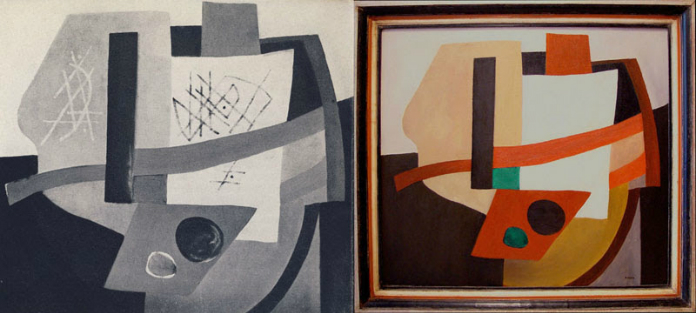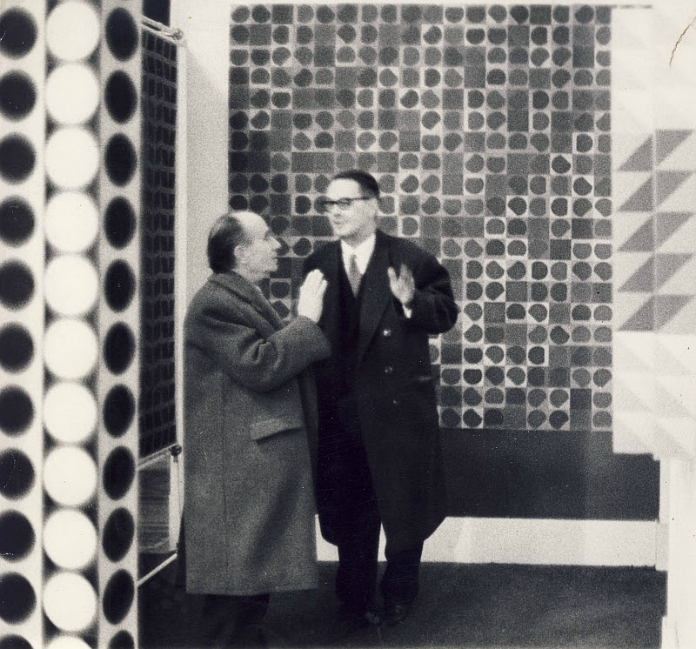Interest and supersession
Kassák and Kassák 2 - Exhibition
In the northern district of Buda, in a little museum named after Lajos Kassák, a revolutionary avant-garde artist, an exhibition devoted to the eponym has just opened.
| György Péter |
2014-04-08 19:36 |
Art-historians and art-dealers rediscovered the Eastern-European avant-garde at the same time: in the 1960s. Kassák’s reputation was re-established in Western-European art life due to this interest. After his exhibitions in Paris in 1960 and 1963, more followed in Geneva, Munich, London, Cologne, Turin, New York and elsewhere. This Western interest was sparked by his consistent approach to art that bore no sign of digression. After Paris he returned to topics he had covered in the early 1920s, and switched to a stricter tone concerning his lyrical, abstracts paintings at the end of the 1950s. After his death numerous fakes turned up all over the world. Despite the Paris exhibitions, in Hungary Kassák, the abstract painter, was rejected by the dominantly conservative art world as well as by those in power. He could only have exhibitions at low-key venues. For the socialist state bureaucrats abstract art, by definition, was intolerable, while the art world thought he was a dilettante. In spite of all this, his personal charisma made him an outstanding figure of Hungary’s intellectual life even at an old age. Kassák became the archetype of the leftist, modernist art revolutionist. And here is what Péter György of Eötvös Lóránd University said at the exhibition opening.
Let me recall the time, several decades ago, when I first came to this building. At that time the great Ferenc Csaplár was the director here, and this museum seemed to be a place of exile as well as a hopeful but secret archive. Every museum inevitably reflects the epoch that created it in a complex and often unfathomable way. But it also reflects the judgement its contemporaries make about it. At that time this museum precisely indicated the judgement about Kassák, as Edit Sasvári says it, the state of interest and supersession at the same time. Kassák, no question, deserved an independent museum in his very own neighbourhood. The state bureaucrats new it very well that this strange painter, writer, poet, program writer, a beacon for generations of artists, this great, little, brave, obstinate old man deserved the chance to be appreciated by later generations. However, they most probably did not expect exhibitions like this one in this building. A museum was due to Kassák, they might have thought, but possibly far from the city centre. The location and the size of the space relentlessly, as we would say today, put a price tag on Kassák, who was on the periphery of both literary and art history. These two fields incorporated him, but, as a mater of fact, the latter especially has not fully comprehended why Kassák’s oeuvre is more significant on the international scene than those of several great professional masters, and why it lacks provincialism while it is simple and as unpretentious as anything can be.
Kassák was a unique figure of those long decades when Hungarian art, due to the strict borders and the socio-political situation, slowly and irreversibly disappeared form the European art world. This process began precisely when Kassák went to Vienna after 1919 where he had the chance to follow the most influential art trends, and although he did not speak foreign languages, with the help of his friend, Endre Gáspár, he much more comprehensively grasped what was happening there at that time than many others. And as far as I see he never forgot what he had learnt there. A long time passed between 1926 and the 1960s when he could get back to Paris. By that time Kassák had become forgotten and he himself did not understand immediately what the West was offering to him. Nevertheless, he had always retained his independence and autonomy and did not get perplexed when facing the large museums and galleries in Paris. It is surely open to debate why Denise Renée needed Kassák, or how it happened that some giants of Hungarian fine art like Aurél Bernáth, Dezső Korniss, Endre Bálint and Tibor Csernus, even if they were present in the West, were not much in demand. Kassák, however, was regarded as a team A player, and one of the greatest ones indeed. True enough, he never played a full half, was mostly sitting on the bench, but still, almost the only artist of ours whose works were worth forging. It is also a question why and how this vulnerable man could achieve that his art remained important after his death.
 |
Kassák Lajos: Komposition
|
I would like to share a personal memory with you now, since, in fact, I knew Kassák Lajos’s wife. After 1998 I was working on a Kassák monograph and I spent a lot of time in his home. Klára Kassák was a very intelligent woman, she was brave with a lot of willpower, not scared by either lung cancer or by loneliness, and she knew exactly what she wanted to achieve. She wanted her husband to be known, to be someone. Her only delusion was that her husband was already someone, nevertheless, she wanted the whole world to know and to appreciate him. After some time, I realised that Kassák’s comeback in the 1960s had kept turning up in our conversations with Klára. Quite understandably, since it was Kassák’s most difficult period when Imre Pán, a critique, colleague and art organiser, immigrated to France taking many of Kassák’s works with himself. When Kassák slowly awoke to this, a significant part of his oeuvre had already been in Paris. Klára Kassák had a story about this awakening: in 1957 – I might be wrong about the year – but after the revolution against the communist regime, one evening the doorbell rang and an American doctor was at the front door. He was a Hungarian emigrant and wanted some pictures and when Kassák showed him the painted doves he had made in Békásmegyer the guest asked for some earlier works. He wanted the earlier paintings, those ones that Kassák did not like at all and was almost ashamed when finally he put them on display. For a long time he had not believed that anybody would be interested. And suddenly this American doctor walked in and wanted to buy some of them. He offered an unreasonably high price, but they turned him down because they were proud and happy. Finally the American agreed on sending some easels to Kassák from New York, the types Kassák had always needed, and also some paper which was not available here in Hungary. And then this man disappeared and never got in touch again, so there was no money, no paper, no paint only renown.
 |
Victor Vasarely and Kassák Lajos in Musée des Arts Décoratifs, Paris, 1963
Photo: André Morain
|
Many decades later we can say that Hungarian art has not moved much ahead since then. A different horizon, a different political system, but we are living on the periphery of the contemporary art world, and we need Kassák now as much as we needed him then, because one hand is enough to count the artists here who are as matter-of–factly prideful as he was. As years are passing by, I see more and more similarities between the behaviour of Kassák and Illyés. Neither was educated, both were outsiders, obstinate and proud, and these similarities are still remarkable even if their artistic credos and careers were different. But the point is that both did have a credo and what once they thought up they stuck to despite all inevitable tactics, silence and concealment. What we can learn from this exhibition is the secret to a long life. Kassák lived for 80 years, not a short time in this corner of the world, and quite long even in the West. He was as much lonely as vulnerable, and as much unrelenting as unerring. I really do not know how he could retain this ability of his youth to judge how much each “–ism” is worth, but he infallibly found his way on a complicated map, and he was very brave even when he had not been in the West for a long time, when his time was already up. Kassák was a great friend of Ferenc Mérei who also knew how it was possible to be happy as an outsider. Mérei used to say that one does not have to benefit all the time. Kassák did not benefit all the time. And still he benefited the most.